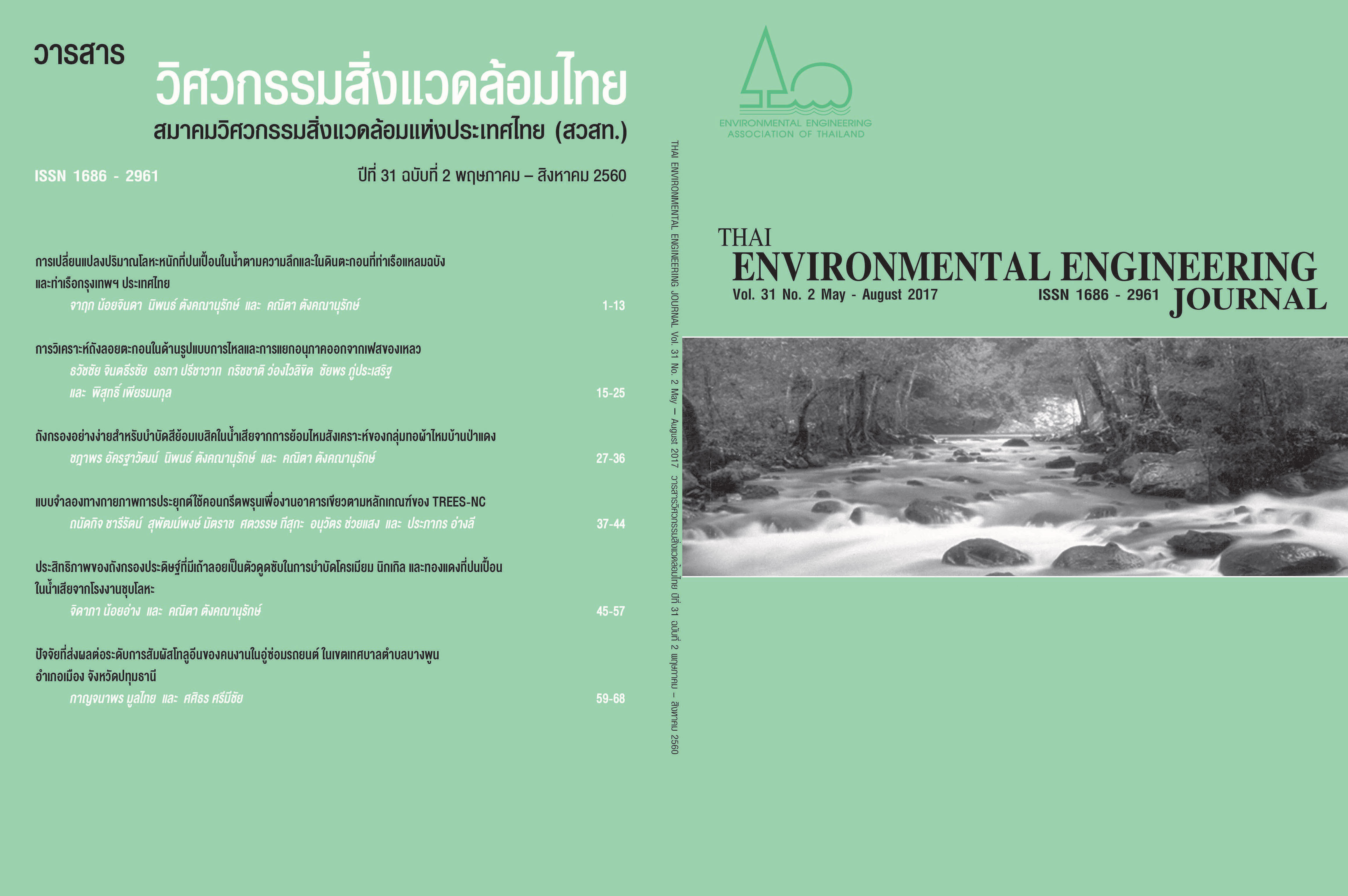Efficiency of Constructed Filter Tank with Fly Ash as Adsorbent in Treatment of Wastewater of Metal Plating Factory Contained with Chromium Nickel and Copper
Main Article Content
Abstract
This research aims at investigating the development a low cost constructed filter tank with coal fly ash for the removal of Chromium (Cr) Nickel (Ni) and Copper (Cu). These metals are widely used in a metal plating industry and finds theirs way to the aquatic environment through wastewater discharge. Three types of fly ash namely FA1, FA2 and FA3 were by-product from different ratio of coal and biomass (70:30, 90:10and 100:0respectively) combustion. The adsorption efficiency of 3 fly ashs were similar. In 50 ml of synthetic wastewater consist of 80, 40 and 30 ppm of Cr, Ni and Cu respectively,as much as 2.7005, 1.9992 and 1.4968 mg removal of Cr, Ni and Cu were achieved in about 1 hours under the batch test condition. The adsorption capacitys of Cr, Ni and Cu were 0.46, 0.40 and 0.30 mg/g respectively. The adsorption isotherm was consistent with the Langmuir and Freundlich isotherm. Column lab scale experiment was performed in glass column ( 6.5 cm i.d. x 40 cm H) which packing with 3 filter layers consist of stone, sand, mixture of FA and sand (1:30) from top to bottom. The Cr removal efficiency of 3 fly ashs were increased about 20% from batch experiment. Moreover from breakthrough point and exhaustion point, column with FA3 was found to be a longer useful life than FA2 and FA1 respectively. In addition, the constructed filter tank was reproduced in plastic tank (18.925 L capacity) with containing the 3 filter layers which consist of FA3. At the 1st time of treatment, 222.13 mg of Cr 159.34 mg of Ni and 119.10 mg of Cu were removed. Therefore, there are good prospects for the removal of these metals on constructed filter tank with fly ash FA3 adsorbent in practical applications in metal plating factory wastewater.
Article Details
References
[2] Bayat, B., 2002, Comparative study of adsorption properties of Turkish fly ashes:II. The case of chromium (VI) and cadmium (II), J. Hazard. Mater. B95: 275-290.
[3] Bayat, B., 2002, Comparative study of adsorption properties of Turkish fly ashes: I. The case of nickel(II), copper(II) and zinc(II), J. Hazard. Mater. B95: 251-273.
[4] Gupta, G. and Torres, N., 2002, Use of fly ash in reducing toxicity of and heavy metals in wastewater effluent, J. Hazard. Mater. 57: 243-248.
[5] US Environmental Protection Agency, 2007, Method 3015A Microwave Assisted Acid Digestion of Aqueous Samples and Extracts, Available Source: https://www.epa.gov/sites/production/files/2015-12/documents/3015a.pdf, August 31, 2015.
[6] Department of industrial works, 2008, Manual of Metal Finishing Industry, DM Printing Company Limited Bangkok, 262. (in Thai)
[7] Tangkananuruk, N. and Tangkananuruk, K., 2007, Principles of Chemical Water Quality Analysis, Kasetsart University Press, Bangkok, 281. (in Thai)
[8] Chindraprasirt, P., 2004, Fly Ash in Concrete, Thai Concrete Association, Bangkok, 109. (in Thai)
[9] Matthayan, W., Visitsak, S. and Khedari J., 2011, Improvement of compressive strength for adobe block by using lime and palm oil ash, Available Source: http://rdi.ku.ac.th/kasetresearch54/GroupEconomic/43-Worawut_mat/template.html, December 18, 2015.
[10] Reynolds, T. D. and Richards, P. A., 1996, Unit Operations and Processes in Environmental Engineering, PWS Pub., Boston, 798.

